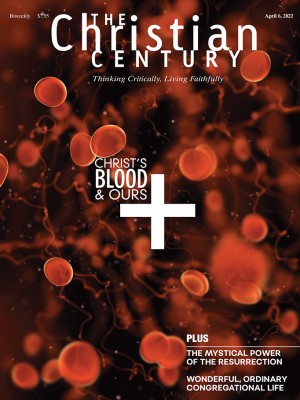The wonderful ordinariness of congregational life
Sometimes it’s boring. Sometimes it’s thrilling. Sometimes it makes me cry.

The first thing I notice when I ease into my seat is her hair. Except for the long months of the seemingly endless pandemic, I’ve been sitting behind Deidre Worthington for close to 20 years. Although there was that time, for a year or two, when she and her husband, Bertram, stopped coming because the sanctuary was going to be remodeled, and not to their liking. Somehow replacing the 1950s aqua bathroom tile mosaic backdrop behind the altar with simple board and batten was an affront not only to them but also to God.
This evening I am puzzled. Deidre’s short, blonde-highlighted hair is usually sleek, not a hair amiss. Proper and befitting an elegant transplanted British Anglican living in Berkeley and married to a rather dour, silent man who took on the role of parish archivist to make sure someone else didn’t do a sloppy job. Deidre is the long-suffering head of the altar guild, the women—always women—who wash and iron and starch the various white altar cloths, polish the brass and silver, arrange the seasonal floral displays flanking the choir, and, most important, never complain. Deidre has been briskly commanding that hardy group for as long as I have been sitting in the fourth pew from the front, and she has resumed her duties now that we are gathering in person again.
Read our latest issue or browse back issues.
Tonight Deidre’s hair is not smooth, not sleek. Little tufts stick up, out, sideways in the back and on the sides. Her tousled bangs look as though she has not recovered from the severe ruffling of a violent windstorm. I am surprised. I can’t help but stare, trying not to be obvious. I can detect no apparent cause in her expression or demeanor, just a slight forward curve in her usually upright slender back. But it feels like a disturbance in the congregational field.
I’m always watching for disturbances, practicing a sort of back-of-the-head forensics as my attention drifts during an awkward seminarian sermon or jolly announcements about the parish camping trip or those inevitable lags and drags in the liturgy. Over the years I have spent hours observing the backs of my fellow congregants’ heads, made easy by the forward-facing arrangement of the pews. Hair is often a reliable indicator of someone’s inner state, including the gradual unraveling of old age.
One week a gruff retired engineer’s wiry, white, close-clipped hair is Marine tidy; the next it has devolved into a landscape of tufted, overgrown whorls. Then I note that he has dual hearing aids and has stopped singing in the choir. He still wears his Harris Tweed sports jacket, sharply creased slacks, and starched white shirt and tie, but something seems to have happened. The keen edge that led him to warn me, when I was a newcomer, that “they’ll be after your money soon enough” seems to be gone.
Sometimes hairdos indicate more than a lost edge in my pew-mates. One Easter morning, as we rose to belt out “Christ Is Risen,” Mary Mackey tipped over and out of her seat in the front row and cracked her head. Mary was immediately surrounded and comforted by friendly parishioners as someone called 911. The paramedics arrived in a few minutes to minister to her and wheel her out to the waiting ambulance, while we all sat hushed as the revolving red lights flashed through the stained-glass windows. It wasn’t serious, thankfully, but Mary had been having trouble for some time. I had seen it coming as her tinted reddish-brown, salon-curled hair gradually turned white and limp. The Easter liturgy resumed after Mary’s departure but in a subdued manner, all of us chastened at the prospect that we too might someday topple rather than rise.
Sitting in the pews week after week, year after year, is like perching on the edge of a geologic event, a slow-slipping fault. Change in those around me is sometimes slow and imperceptible, sometimes precipitous and surprising. One week Nancy and Dorothy and Margie and Dave are in their usual spots, greeting me heartily as we pass the peace. The next it seems Nancy has descended into dementia, Dorothy has moved across the country to live with her son, and Margie’s comforting bulk has dwindled so much that her clothes hang on her as she makes her way unsteadily up the aisle during the Eucharist. And Dave just doesn’t come anymore. I never find out why.
These changes are not only driven by illness and decline. I watch the frisky toddler who used to grind her Cheerios into the rug and howl during the prayers of the people become an acolyte, swelling with seriousness and pride as she swings the smoking censer at the Christmas Eve service. I wonder what happened to the three dark-haired daughters and their handsome parents—they used to come every week, all of them in dress-up clothes (unlike most of the rest of us). They were there for what seemed like years, then came no more. Did they move away? Succumb to a teenage allergy to church? There are no clues in the parish bulletin, but then I never knew their names.
I have been here in this pew for so many years of Sundays that I see young pregnant women bring their babies to be baptized, then watch those babies grow from exuberant children into fake-bored middle schoolers, then leave after high school, seldom to be seen again. One Sunday our music director, an erudite, eccentric, bald-headed, self-proclaimed music nerd, is wearing a supportive neck collar because the degenerative disease he’s been living with for years is suddenly progressing. Just months later he can no longer play the organ, pluck his homemade washtub bass with the folk ensemble, or lead the choir. Just a short time later, he dies, and we mourn him. But we keep singing those same antique hymns and angular modern pieces that were so dear to his heart.
I am stitched into the fabric of this congregation and its rhythms like a button on a sweater, a little outside but firmly attached. I am a regular attender but prone to criticism and irritation at some of the off-putting petty goings-on or clergy mishaps that lead me away from time to time. I always come back. And when I do I attend not just Sundays but all the holy days. On Christmas Eve I smile at the wacky, improvised children’s pageant, with its manic toddlers in lamb suits and angel wings and a real baby on loan to play Jesus. After a few years, the chaos and crowds start to bother me, so I switch to the later lessons and carols service and join the joyful throng belting out the corny, well-worn Christmas carols in the candlelit darkness.
At Holy Week, I sink into each of the liturgies. Maundy Thursday brings eager acolytes who dart around, keeping all of us supplied with warm water and towels for our foot washing. I’m paired with a very large man I’ve never talked to or even greeted in the peace. His bare, purply feet are twisted and swollen, his toenails thick yellow horns on scaly toes. Yet I gladly wash them, trickling the warm water over each one, then drying them gingerly with a thick white towel. I don’t look in his eyes; he seems a little embarrassed, and I doubt he’d ever submit to anything like this except in this liturgy. He does the same for me, and it all seems right.
I can’t explain why this is so thrilling to me every year, except that we all know this is the doorway to Easter, and it begins with the story of Jesus washing his disciples’ feet as they protest, or like Peter—always Peter—clumsily try to make more out of it. They don’t know, as we do, that the days of darkness and death—and then resurrection—will follow.
Two days later, on Saturday, I creep into the courtyard in the damp, cold Berkeley night to watch the kindling of the holy Easter vigil fire, which begins the most sacred (and longest) liturgy of the year. This is the anniversary of my baptism 20 years ago, when I stood in front of the congregation with two little redheaded girls and my friend Sandy, a Berkeley psychiatrist who had found her way from an indolent agnosticism to faith by way of the blessing of the animals on the feast day of St. Francis. She came from secular Judaism, I from lapsed Mormonism, to be sprinkled and blessed while everyone in the sanctuary watched, clutching their little white candles and holding us up as we promised to be Christ’s own forever.
On Easter morning, I wedge into my seat, the sanctuary fuller than usual because of the influx of people who only come a couple times a year. Next to me, though, is my favorite acolyte, the one who is so transported every time she serves. Hers is not the perfunctory, hesitant performance I’ve sometimes observed; she sings enthusiastically, confidently says the Nicene Creed she’s obviously memorized, follows the entire liturgy, and smiles her way from the first prayer to the last amen. But she’s not serving today. This Easter she is dressed in a beautiful, seafoam blue dress with artful layers of lace netting and embroidery, her shiny dark hair caught up in a little bun encircled with a matching blue ribbon. I glance sideways at her as she smooths the skirt down, preens a little in the awareness of how pretty she looks, and yet is as serious as ever about singing, praying, and entering wholly into the spirit of the day.
I don’t know her, but she is one of my favorite parts of coming to church because she reminds me of myself as a teenager, one of those girls who is entirely serious about church, God, faith. I wasn’t an acolyte because that wasn’t done in the church I was going to, but I believed, and that belief held deep meaning for me. That must be why I returned to church as a 50-year-old, after 30 years of wandering around and looking into the windows of all kinds of other spiritual options, none of which had the same gravitas for me as being part of a Christian community. Of being a Christian—or trying to.
It’s a wonderfully ordinary path, being a churchgoing Christian. Sometimes it’s boring. Sometimes it’s thrilling. Sometimes I feel completely plugged in, surrounded by love and spirit. Sometimes it makes me cry because I am so moved. Other times it’s a little empty, and it feels like the most interesting thing going on is the mysterious ruffling of Deidre Washington’s hairdo. Especially after being kept away from it for so long by the COVID virus, I gratefully ease in and out of it all, this congregational life, seeking to be part of a long arc of love, devotion, faith, obedience, doubt, belonging, error, confession, reconciliation, and sometimes joy. As I sit in my pew, I am floated on the birdsong and squawks of babies gurgling and fussing, on the plainsong of chanted psalms, on the crescendo of the sung Eucharist, on the hum of greeting at the passing of the peace and the murmured prayers. Floated, that is, on the life of this congregation.
A version of this article appears in the print edition under the title “This congregational life.”






